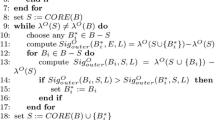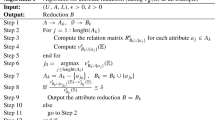Abstract
In multi-label learning, the classification obtained by attribute set is usually inconsistent with that based on label set. This makes multi-label learning to possess fuzziness and uncertainty, which leads to the poor performance of learning algorithms. To address this fuzziness and uncertainty, this paper first combines multiple labels into a granulation multi-label decision function by using the classification obtained by attribute set. Then we give three kinds of formulations to construct the granulation multi-label decision functions, which are divided three levels, that is, macroscopic level, mesoscopic level and microscopic level. Moreover, by using the granulation multi-label decision function, this paper provides the method that transforms a multi-label decision table into a granulation multi-label decision table. Then three-level granulation attribute reductions of a multi-label decision table are defined and investigated. Furthermore, this paper shows that the existing multi-label attribute reduction, complementary decision reduction, can be viewed as the coarsest granularity reduction proposed by this paper, that is, a macroscopic-level granulation attribute reduction. In summary, this paper establishes a relatively systematic theoretical framework for attribute reduction of multi-label data based on rough set theory. Finally, by several comparative analysis, the reasonability, feasibility and effectiveness of these granulation attribute reductions are demonstrated.







Similar content being viewed by others
Notes
The datasets are available at http://mlkd.csd.auth.gr/multilabel.html#Datasets.
References
Bhatt R, Gopal M (2005) On fuzzy rough sets approach to feature selection. Pattern Recognit Lett 26(7):965–975
Che X, Chen D, Mi J (2022) Label correlation in multi-label classification using local attribute reductions with fuzzy rough sets. Fuzzy Sets Syst 426:121–144
Chen Z, Liu K, Yang X, Fujita H (2022) Random sampling accelerator for attribute reduction. Int J Approx Reason 140:75–91
Chen D, Zhao S (2010) Local reduction of decision system with fuzzy rough sets. Fuzzy Sets Syst 161(13):1871–1883
Hashemi A, Dowlatshahi M, Nezamabadi-pour H (2020) MFS-MCDM: multi-label feature selection using multi-criteria decision making. Knowl-Based Syst 206:106365
Hu L, Gao L, Li Y, Zhang P, Gao W (2022) Feature-specific mutual information variation for multi-label feature selection. Inf Sci 593:449–471
Hua M, Tsang E, Guo Y, Chen D, Xu W (2021) A novel approach to attribute reduction based on weighted neighborhood rough sets. Knowl-Based Syst 220:106908
Li D, Li H, Zhai Y (2016) A novel attribute reduction approach for multi-label data based on rough set theory. Inf Sci 367-368:827–847
Lin Y, Hu Q, Liu J, Chen J, Duan J (2016) Multi-label feature selection based on neighborhood mutual information. Appl Soft Comput 38:244–256
Lin Y, Li Y, Wang C (2018) Attribute reduction for multi-label learning with fuzzy rough set. Knowl-Based Syst 152:51–61
Liu J, Lin Y, Du J, Zhang H, Chen Z, Zhang J (2022) ASFS. A novel streaming feature selection for multi-label data based on neighborhood rough set, Appl Intell. https://doi.org/10.1007/s10489-022-03366-x
Pawlak Z (1982) Rough sets. Inf Sci 11(5):341–356
Qian W, Xiong C, Wang Y (2021) A ranking-based feature selection for multi-label classification with fuzzy relative discernibility. Appl Soft Comput 102:106995
Siblini W, Kuntz P, Meyer F (2021) A review on dimensionality reduction for multi-label classification. IEEE Trans Knowl Data Eng 33:839–857
Tan A, Liang J, Wu W, Zhang J, Sun L, Chen C (2021) Fuzzy rough discrimination and label weighting for multi-label feature selection. Neurocomputing 465:128–140
Tsang E, Chen D, Yeung D, Wang X, Lee J (2008) Attributes reduction using fuzzy rough sets. IEEE Trans Fuzzy Syst 16(5):1130–1141
Wang C, Shao M, He Q, Qian Y, Qi Y (2016) Feature subset selection based on fuzzy neighborhood rough sets. Knowl-Based Syst 111(1):173–179
Yang X, Li M, Fujita H, Liu D, Li T (2022) Incremental rough reduction with stable attribute group. Inf Sci 589:283–299
Yao Y (2018) Three-way decision and granular computing. Int J Approx Reason 103:107–123
Yao Y (2020) Tri-level thinking: models of three-way decision. Int J Mach Learn Cybern 11:947–959
Yao Y, Zhang X (2017) Class-specific attribute reducts in rough set theory. Inf Sci 418-419:601–618
Yao Y, Zhao Y (2009) Discernibility matrix simplification for constructing attribute reducts. Inf Sci 179:867–882
Yao Y, Deng X (2014) Quantitative rough sets based on subsethood measures. Inf Sci 267:306–322
Zhang X, Fan Y, Yang J (2021) Feature selection based on fuzzy-neighborhood relative decision entropy. Pattern Recognit Lett 146:100–107
Zhang P, Gao W, Hu J, Li Y (2021) Multi-label feature selection based on the division of label topics. Inf Sci 553:129–153
Zhang X, Yao H, Lv Z, Miao D (2021) Class-specific information measures and attribute reducts for hierarchy and systematicness. Inf Sci 563:196–225
Acknowledgements
This work is supported by the Natural Science Foundation of Shanxi Province, China (No. 202103021224261). This paper is reprint from https://assets.researchsquare.com/files/rs-1196027/v1_covered.pdf?c=1644248003.
Author information
Authors and Affiliations
Contributions
Conceptualization, Methodology, Formal analysis. Xiaoping Zhang: Software, Visualization.
Corresponding author
Ethics declarations
Competing interests
The authors declare that they have no known competing financial interests or personal relationships that could have appeared to influence the work reported in this paper.
Additional information
Publisher’s note
Springer Nature remains neutral with regard to jurisdictional claims in published maps and institutional affiliations.
Rights and permissions
Springer Nature or its licensor (e.g. a society or other partner) holds exclusive rights to this article under a publishing agreement with the author(s) or other rightsholder(s); author self-archiving of the accepted manuscript version of this article is solely governed by the terms of such publishing agreement and applicable law.
About this article
Cite this article
Wang, Z., Zhang, X. The granulation attribute reduction of multi-label data. Appl Intell 53, 19266–19284 (2023). https://doi.org/10.1007/s10489-023-04510-x
Accepted:
Published:
Issue Date:
DOI: https://doi.org/10.1007/s10489-023-04510-x




